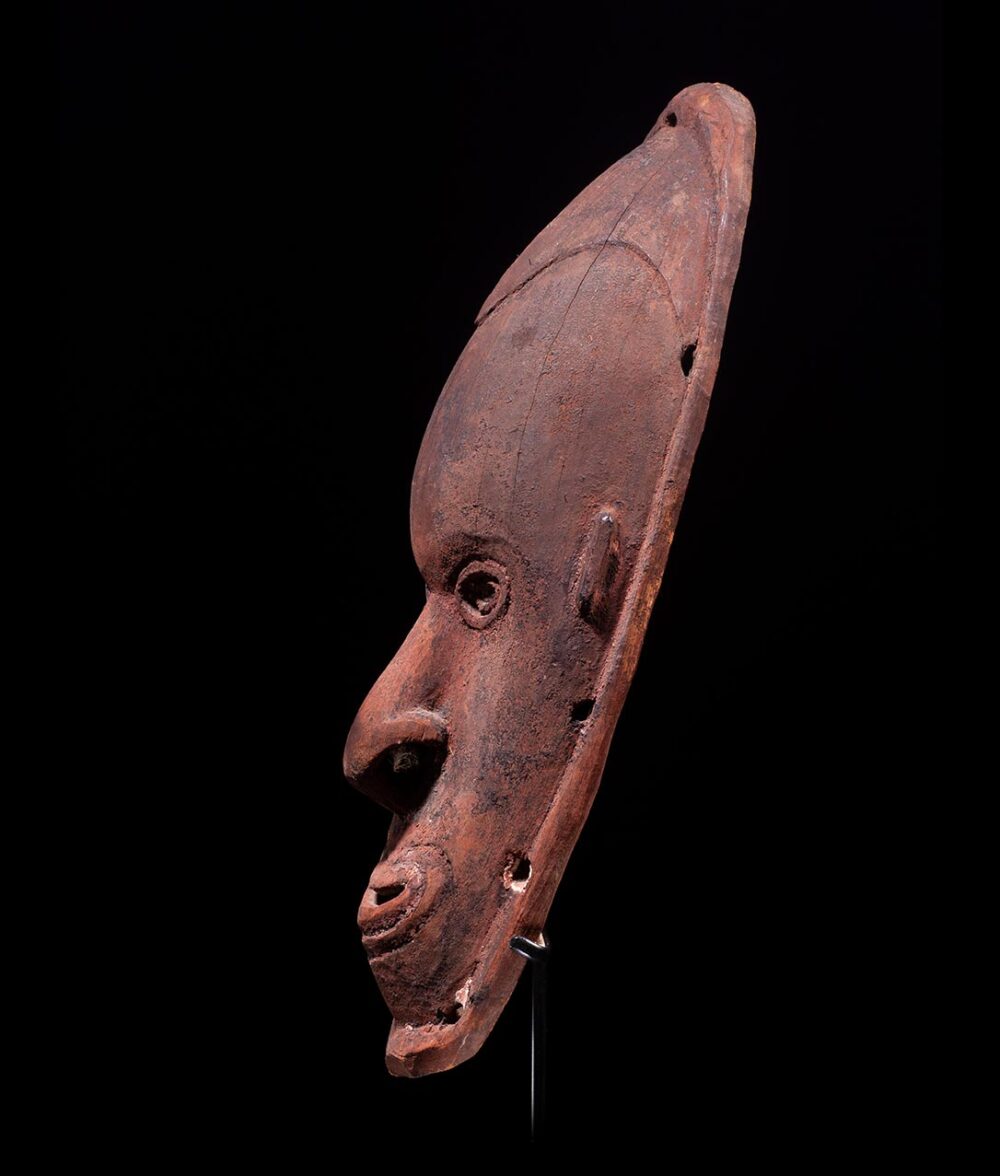Mask, Murik Lakes
Murik Lakes, Coastal Sepik River region,
Papua New Guinea
19th c.
Provenance: Field collected in the Murik Lakes region in 1936 by Louis Pierre Ledoux, Lincoln Park, NJ. Rene d’ Harnoncourt, NY, acquired as a gift in 1945 from Louis Ledoux. By descent to Ann d’Harnoncourt, Philadelphia
Published: The Museum of Primitive Art, Two Private Collections: Gertrud A. Mellon and René d’Harnoncourt, New York, 1965, n.p., cat. no. 64 (listed)
Exhibited: The Museum of Modern Art, New York, Art of the South Seas, January 29 – May 19, 1946. The Museum of Primitive Art, New York, Two Private Collections: Gertrud A. Mellon and René d’Harnoncourt, November 29, 1965 – February 11, 1966
This is a remarkable and deeply expressive Murik Lakes mask, boasting a distinguished provenance and an illustrious exhibition history. Its significance is heightened by its early acquisition in the 1900s by Louis Ledoux, followed by its ownership by Rene d’Harnoncourt, the former director of The Museum of Modern Art in New York. Furthermore, it gained exposure at the historic and momentous 1946 exhibition “Art of the South Seas,” organized by d’Harnoncourt.Carved meticulously without the use of non-metal tools, this ancient mask stands as a true archetype. The visage exudes a commanding presence, created with exceptional precision and symmetry. Notably, the mask features perforations around the rim for attachment, along with a pierced septum, which are crucial characteristics in Oceanic art. The patina adorning this mask tells the tale of generations of use, having an encrusted and aged surface and patina. Astonishingly, the original red ochre pigment still blankets the surface in excellent condition.
Rene d’Harnoncourt (1901-1968) was a visionary curator and influential figure during his years at The Museum of Modern Art (MoMA). Serving as the director of MoMA from 1949 to 1968, he left an indelible mark on the institution’s legacy. Under his dynamic leadership, MoMA evolved into a leading cultural hub, promoting avant-garde and groundbreaking art from around the world. D’Harnoncourt’s deep appreciation for diverse art forms led him to explore and showcase art from various cultures, including the mesmerizing works of Oceanic art.
One of his most noteworthy contributions was the historic “Art of the South Seas” exhibition held in 1946 at MoMA. This groundbreaking showcase brought Oceanic art into the forefront of the art world, captivating audiences with its rich cultural significance and artistic brilliance. Through his keen eye and dedication to promoting cross-cultural understanding, d’Harnoncourt opened a window to the South Pacific’s artistic heritage, fostering appreciation for these masterful creations. His legacy as a curator and advocate for global art continues to resonate within the art community, shaping the way we perceive and celebrate cultural diversity in the realm of modern art.
Mask
Murik Lakes, Coastal Sepik River region,
Papua New Guinea
19th c.
Provenance: Field collected in the Murik Lakes region in 1936 by Louis Pierre Ledoux, Lincoln Park, NJ. Rene d’ Harnoncourt, NY, acquired as a gift in 1945 from Louis Ledoux. By descent to Ann d’Harnoncourt, Philadelphia
Published: The Museum of Primitive Art, Two Private Collections: Gertrud A. Mellon and René d’Harnoncourt, New York, 1965, n.p., cat. no. 64 (listed)
Exhibited: The Museum of Modern Art, New York, Art of the South Seas, January 29 – May 19, 1946
The Museum of Primitive Art, New York, Two Private Collections: Gertrud A. Mellon and René d’Harnoncourt, November 29, 1965 – February 11, 1966
This is a remarkable and deeply expressive Murik Lakes mask, boasting a distinguished provenance and an illustrious exhibition history. Its significance is heightened by its early acquisition in the 1900s by Louis Ledoux, followed by its ownership by Rene d’Harnoncourt, the former director of The Museum of Modern Art in New York. Furthermore, it gained exposure at the historic and momentous 1946 exhibition “Art of the South Seas,” organized by d’Harnoncourt.Carved meticulously without the use of metal tools, this ancient mask stands as a true archetype. The visage exudes a commanding presence, created with exceptional precision and symmetry. Notably, the mask features perforations around the rim for attachment, along with a pierced septum, which are crucial characteristics in Oceanic art. The patina adorning this mask tells the tale of generations of use, having an encrusted and aged surface and patina. Astonishingly, the original red ochre pigment still blankets the surface in excellent condition.
Rene d’Harnoncourt (1901-1968) was a visionary curator and influential figure during his years at The Museum of Modern Art (MoMA). Serving as the director of MoMA from 1949 to 1968, he left an indelible mark on the institution’s legacy. Under his dynamic leadership, MoMA evolved into a leading cultural hub, promoting avant-garde and groundbreaking art from around the world. D’Harnoncourt’s deep appreciation for diverse art forms led him to explore and showcase art from various cultures, including the mesmerizing works of Oceanic art.
One of his most noteworthy contributions was the historic “Art of the South Seas” exhibition held in 1946 at MoMA. This groundbreaking showcase brought Oceanic art into the forefront of the art world, captivating audiences with its rich cultural significance and artistic brilliance. Through his keen eye and dedication to promoting cross-cultural understanding, d’Harnoncourt opened a window to the South Pacific’s artistic heritage, fostering appreciation for these masterful creations. His legacy as a curator and advocate for global art continues to resonate within the art community, shaping the way we perceive and celebrate cultural diversity in the realm of modern art.











